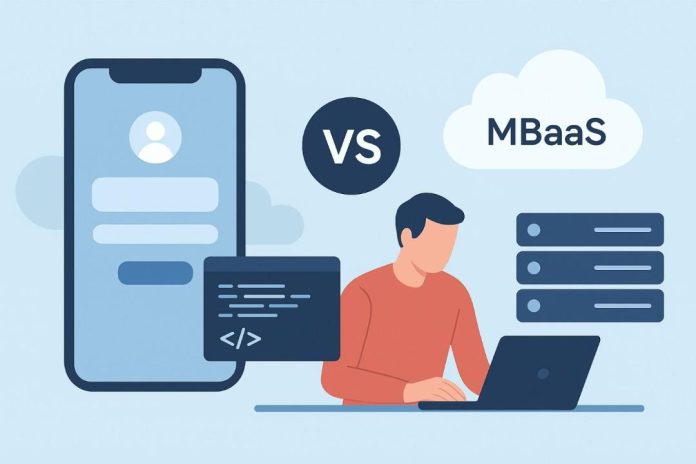Choosing how your mobile app will run behind the scenes is one of the most important architectural decisions you will make. The backend determines how fast your app scales, how secure your data is, and how easily it integrates with other systems. In 2025, there are two dominant paths: building a custom mobile app backend or using a Mobile Backend-as-a-Service (MBaaS) platform.
This article helps you decide which route makes sense for your business goals, resources, and long-term roadmap.
Table of contents
- What Is a Mobile App Backend?
- Understanding MBaaS (Mobile Backend-as-a-Service)
- What Is a Custom Backend?
- Custom vs MBaaS: Head-to-Head Comparison
- How to Choose Between MBaaS and Custom Backend
- Hybrid Approaches Emerging in 2025
- Cost and Time Comparison
- Common Migration Scenario: MBaaS to Custom Backend
- When to Partner with a Backend App Development Company
- Conclusion
What Is a Mobile App Backend?
Before comparing models, it helps to understand what the backend actually does. The mobile app backend is the core system that handles data storage, business logic, user authentication, and API communication. It connects your mobile interface to databases, third-party tools, and enterprise systems.
When a user logs in, uploads a file, or receives a push notification, the backend processes that request. Whether you use an MBaaS or custom backend, these core functions remain constant—the difference lies in how you build, manage, and scale them.
Understanding MBaaS (Mobile Backend-as-a-Service)

MBaaS platforms such as Firebase, AWS Amplify, Backendless, and Supabase provide developers with ready-made backend infrastructure. You get tools for authentication, data storage, file hosting, and push notifications without having to build everything from scratch.
According to recent development surveys, MBaaS adoption continues to rise in 2025 because it accelerates launch time and reduces early engineering costs. The trade-off is flexibility: you rely on vendor limitations for customization, performance tuning, and long-term pricing.
Advantages of MBaaS:
- Fast development and deployment
- Built-in scalability for basic workloads
- Simplified user authentication and data sync
- Lower initial infrastructure cost
- Integration with analytics and crash reporting tools
Limitations:
- Vendor lock-in and limited control
- Cost escalation at high usage levels
- Difficult customization for complex business logic
- Limited options for strict data residency or compliance
MBaaS is ideal for startups, MVPs, or internal apps where speed outweighs full customization.
What Is a Custom Backend?
A custom backend is developed specifically for your app’s requirements. It may use frameworks such as Node.js, Django, or Spring Boot, and be hosted on AWS, Azure, or a private cloud environment. Everything, from the database schema to the API endpoints, is designed to match your business rules.
Custom backends are common among enterprises and product companies that require advanced integrations, multi-region deployments, or unique user flows. They typically involve higher initial effort but deliver unmatched control and scalability.
Advantages of Custom Backend:
- Complete flexibility to design architecture and logic
- Better integration with ERP, CRM, and other enterprise systems
- Tailored security and compliance mechanisms
- Easier long-term optimization and scaling
- Technology independence and ownership
Limitations:
- Longer time to build and test
- Higher upfront development cost
- Requires skilled backend engineers
- Ongoing maintenance and DevOps responsibility
Custom backend development is often handled by a backend app development company as part of custom mobile application development services, ensuring that architecture aligns with business and technical goals.
Custom vs MBaaS: Head-to-Head Comparison
| Criteria | MBaaS | Custom Backend |
| Setup Time | Days or weeks | Several weeks to months |
| Initial Cost | Low | Moderate to high |
| Scalability | Vendor dependent | Fully flexible |
| Control | Limited | Full ownership |
| Integration | Works best with standard APIs | Works with any system |
| Security & Compliance | Shared responsibility | Fully customizable |
| Maintenance | Minimal, handled by vendor | Requires internal or outsourced team |
| Vendor Lock-in | High | None |
| Best For | MVPs, prototypes, small apps | Enterprise apps, long-term platforms |
This framework simplifies the evaluation. If your product demands speed to market and low initial investment, MBaaS fits. If your priorities are flexibility, compliance, and custom workflows, a custom backend will better serve you.
How to Choose Between MBaaS and Custom Backend
Making the decision should not depend solely on cost. Consider these practical questions:
- How unique is your business logic?
If your app performs standard tasks such as chat, notifications, or file sharing, MBaaS can handle them. If your workflows are complex or regulated, custom development offers a better fit. - What are your integration needs?
Apps that connect deeply with ERP, CRM, or third-party APIs require full control. MBaaS platforms are limited to predefined connectors. - How critical is compliance?
Industries like healthcare, banking, and government often cannot store sensitive data on shared vendor infrastructure. Custom backend wins here. - What scale do you expect?
MBaaS pricing grows with traffic. If your app expects millions of users or heavy data transactions, building your own backend avoids future lock-in costs. - Who will maintain the backend?
MBaaS minimizes maintenance but restricts freedom. Custom backends need DevOps planning but give complete independence.
Answering these questions helps define the correct balance between time-to-market and long-term control.
Learn how to monitor backend performance in microservice environments.
Hybrid Approaches Emerging in 2025
Many modern teams blend both worlds. A hybrid backend uses MBaaS for core services like authentication and file storage, while deploying custom APIs for business logic or enterprise integrations. While Backend-as-a-Service is a subset of the broader PaaS ecosystem, Statista reports that the global PaaS market is growing at a 20.59% CAGR between 2025 and 2030. This rapid expansion signals increasing reliance on cloud-native backend platforms a trend that extends to MBaaS and hybrid backend architectures
For instance, an e-commerce startup may use Firebase for user login and notifications but host its inventory management APIs on a Node.js microservice. This hybrid model allows speed without sacrificing control.
Industry reports show that hybrid backends are becoming a mainstream practice among digital product companies that want faster MVPs with a future-proof foundation.
Cost and Time Comparison
MBaaS Costs:
- Minimal setup, pay-as-you-go pricing
- Best suited for 1–2 developers with limited backend experience
- Monthly costs rise with user count, storage, and API calls
Custom Backend Costs:
- Requires backend engineers, DevOps setup, and security audits
- Higher upfront investment but predictable long-term cost
- In-house or external teams can handle maintenance
As a rough estimate, MBaaS development for a small app may start at $3,000–$5,000. A fully custom enterprise backend can range from $15,000 upward, depending on integrations, API complexity, and data policies.
Partnering with an experienced custom mobile application development services provider ensures realistic estimates and reusable architecture patterns.
Common Migration Scenario: MBaaS to Custom Backend
Many businesses begin with MBaaS for speed, then outgrow its limitations as their app scales. The transition to a custom backend often happens when:
- API limits restrict performance
- Costs increase rapidly with the user base
- Security or compliance rules tighten
- Need for complex integrations arises
Migration requires data export, API redesign, and redeployment. Planning this early prevents downtime and costly rewrites.
When to Partner with a Backend App Development Company
If your internal team lacks experience with backend architecture, scalability, or data security, working with a backend app development company is a practical move. Such partners can:
- Design modular architectures that scale over time
- Select cloud and database technologies based on workload
- Implement DevOps and CI/CD for smoother releases
- Ensure API reliability and data protection
A professional partner offering custom mobile application development services also manages the transition from MBaaS to custom architecture when your product matures.
Conclusion
In 2025, the right backend strategy is about balance. MBaaS gives you speed and simplicity to get to the market quickly. A custom backend provides flexibility, ownership, and scalability for the future.
For startups and early-stage projects, MBaaS is an excellent starting point. For growing enterprises, a custom backend delivers control and sustainability. The best approach often lies in combining both start fast, then evolve strategically.
If you are evaluating backend options or planning a migration, explore mobile app development services that offer both MBaaS implementation and custom backend development under one roof.











